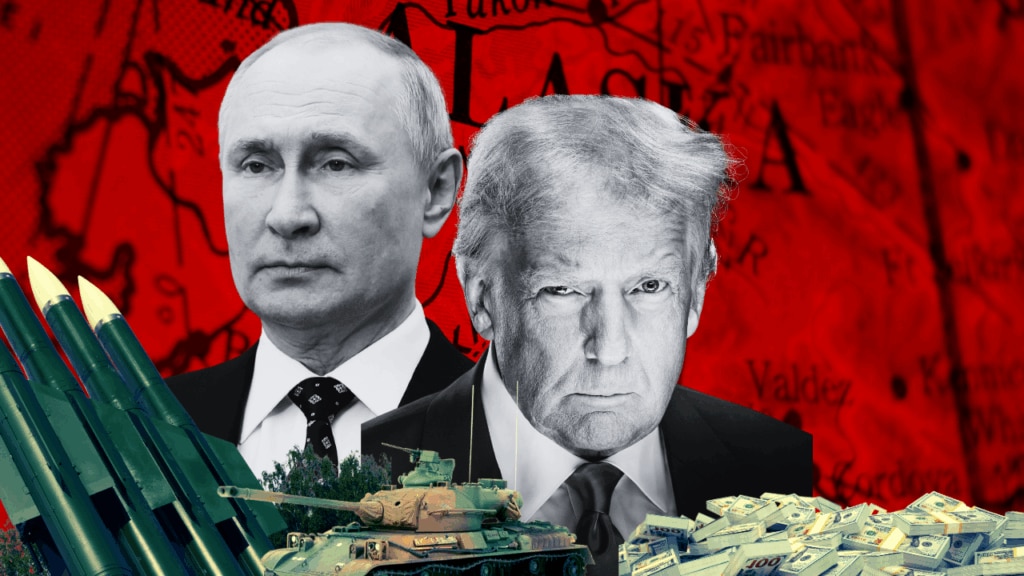Fazal Masood Malik & Farhan Khokhar, Canada

The Alaska summit between Donald Trump and Vladimir Putin concluded on 15 August, exactly as seasoned observers had predicted: with grand pronouncements of “progress” but no tangible peace. This diplomatic theatre masks an uncomfortable reality. After three years, 350,000 military deaths, and $2.7 trillion in global military spending, the Ukraine war persists not despite international efforts but because of them. When defence contractors’ profits soar and energy markets reward the nimble, peace becomes an economically irrational choice.
This is not mere cynicism but an observable fact. Global military expenditure in 2024 increased by 9.4%, the sharpest rise since the end of the Cold War. American defence giants saw remarkable gains, with Northrop Grumman’s stock climbing 37%, General Dynamics 26%, and Lockheed Martin seeing a 24% increase. Each Patriot missile interceptor costs $4 million; America alone has furnished $66.9 billion in military aid. War, it seems, has rarely been better for business.
Conflict at the Ukrainian-Russian border has deep roots in the post-Cold War settlement’s failures. When the Soviet Union collapsed, victorious Western powers expanded NATO eastward without integrating Russia into a new security architecture. Analysts note that expansion was “primarily driven by Central and Eastern European states seeking security guarantees.” Yet dismissing Russian concerns as paranoia has proved catastrophically shortsighted.
The parallel to the Treaty of Versailles merits a worthy consideration, as the unjust peace settlement plants seeds for future conflicts. The 1994 Budapest Memorandum exemplifies this pattern – Ukraine surrendered the world’s third-largest nuclear arsenal for security guarantees that proved worthless when Russia annexed Crimea in 2014. Promises broken become grievances nursed, eventually erupting into violence.
If we consider the economics of wars, the motive of profitability becomes very clear. Russia now devotes 6% of its GDP to defence, employing 3.8 million citizens in arms production. Ukraine has become the world’s largest weapons importer, with purchases increasing nearly 100-fold since 2019. Western defence contractors maintain order backlogs worth hundreds of billions. Lockheed Martin alone sits on $173 billion in future contracts while planning $18 billion in dividends and buybacks through 2027.
These figures reveal a self-reinforcing system where continuation serves more interests than cessation. The Holy Quran’s observation that “And when it is said to them: ‘Create not disorder on the earth,’ they say: ‘We are only promoters of peace.’” (Surah al-Baqarah, Ch.2: V.12) captures this precisely. All parties claim peaceful intent while their actions ensure violence continues. Neither can afford to stop, financially or politically.
The energy markets tell a parallel story. Despite sanctions, Russia still generates EUR 5.4 billion monthly from fossil fuel exports. India increased Russian oil purchases by 300%, saving $13 billion over two years. China now accounts for 47% of Russian crude exports. Europe, despite public condemnation, continues importing Russian gas when convenient.
The teaching of the Holy Prophet Muhammadsa to “help your brother, whether he is an oppressor or he is oppressed” by “preventing him from oppressing others” (Sahih al-Bukhari, Kitab al-mazalim, Hadith 2444) offers wisdom unheeded. The international community failed to stop Russia’s desire for revenge or the West’s victory celebrations, letting anger grow into war.
The US was once the dominant world power, but now several countries, such as Russia and China, compete for influence. This has left a gap in global leadership where the old ways of solving international conflicts don’t work anymore. The UN Security Council remains paralysed by vetoes. Regional powers pursue contradictory strategies that prolong rather than resolve conflict.
India is a good example of this deliberately unclear position, as it increases Russian energy purchases while maintaining Western partnerships. China provides Russia $240 billion in bilateral trade while positioning itself as a potential peacemaker. This fragmentation enables all parties to find alternative support, reducing pressure for compromise.
The human cost of these geopolitical games defies comprehension. Ukraine faces $524 billion in reconstruction costs; its population has declined 25% through death and displacement. Russia has suffered 950,000 casualties – five times its losses in all conflicts since World War II combined, a moral debt beyond any calculation.
Ending this war requires acknowledging hard truths. Total victory for either side remains impossible without nuclear escalation risks. The economic interests perpetuating conflict must be explicitly confronted rather than ignored. Most critically, sustainable peace must address root causes, not merely symptoms.
The USA’s latest diplomatic initiative, threatening 100% tariffs, represents tactics without strategy. Real progress demands structural solutions that make peace more profitable than war. It would be wise for the world leaders to consider some possibilities:
First, internationally supervised referendums in disputed territories could respect self-determination while preventing forced annexation. The Quranic injunction to “be strict in observing justice […] even though it be against yourselves” (Surah an-Nisa’, Ch.4: V.136) provides the ethical framework. It binds both sides to accept outcomes that contradict their claims.
Second, Ukrainian neutrality with security guarantees from both NATO and Russia, enforced by international peacekeepers, could address competing security concerns. This mirrors successful Cold War arrangements in Austria and Finland, proving that neutrality need not mean defencelessness.
Third, phased sanctions relief tied to Russian withdrawal could create economic incentives for peace. Current sanctions, while damaging, have failed to alter behaviour because alternative markets exist. Coordinated relief could make compliance more attractive than resistance.
Fourth, reconstruction funded through frozen Russian assets could rebuild Ukraine while creating economic interdependence. The Marshall Plan demonstrated how former enemies become partners through shared prosperity.
Fifth, truth and reconciliation processes addressing all parties’ war crimes could prioritise healing over revenge. The Holy Prophet Muhammadsa declared that no race is superior to another race; instead, superiority is only through piety and good action. In modern times, Hazrat Mirza Masroor Ahmadaa, Khalifatul Masih V, has expounded on this teaching and highlighted it as a path to peace. (World Crisis and Pathway to Peace, pp. 87-88)
The choice before us
Some might argue this analysis ignores Ukrainian sovereignty or Russian security concerns. Yet precisely because both narratives contain truth, neither side’s absolute victory serves humanity’s interests. The Holy Quran instructs, “And if two parties of believers fight [against each other], make peace between them.” (Surah al-Hujurat Ch.49: V.10)
When mediation fails, the international community must “fight the party that transgresses until it returns to the command of Allah,” (ibid.) meaning justice, not conquest. This divine guidance is available, yet remains unheeded by nations.
The tragedy is not that peace is impossible but that it has become economically inconvenient. Political and economic interests are taking precedence over service to humanity. Defence contractors profit from each day’s continuation. Energy traders arbitrage market disruptions. Geopolitical strategists see opportunity in opponents’ bleeding. Until human lives outweigh quarterly earnings, until justice supersedes advantage, the killing continues.
History offers precedent for wars ending when their profitability ceases. The Thirty Years’ War concluded when exhaustion made peace preferable to victory. The Korean War stabilised when a stalemate became obvious. Today’s technology and economic interdependence should make peace easier, not harder, to achieve. The Iran-Iraq war ended when the world ceased providing weapons to the warring nations.
But today’s wars benefit many different groups, such as investors, workers, and allied countries, giving people reasons to keep wars going, rather than to end them. Russian defence employment, Western military aid, energy market disruptions, and geopolitical realignments all generate conditions opposing peace.
Ultimately, the Alaska summit was a failure because it addressed symptoms, not causes. Until leaders acknowledge that economic incentives drive continuation, diplomatic initiatives remain in theatre. The question is not whether humanity can afford peace but whether it can survive its absence. Each day of delay adds to a bill measured not in currencies but in souls – a debt that compounds beyond any nation’s ability to pay.

